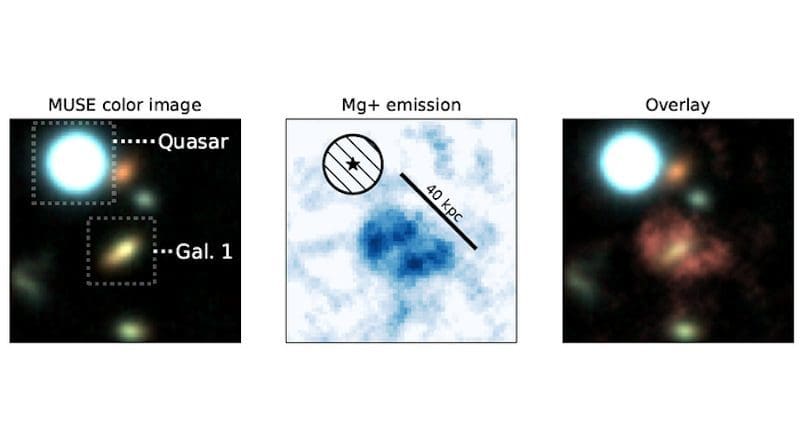Part Of Universe’s Missing Matter Found Thanks To The MUSE Instrument
Galaxies can receive and exchange matter with their external environment thanks to the galactic winds created by stellar explosions. Thanks to the MUSE instrument1 from the Very Large Telescope at the ESO, an international research team, led on the French side by the CNRS and l’Université Claude Bernard Lyon 12, has mapped a galactic wind for the first time. This unique observation, which is detailed in a study published in MNRAS , helped to reveal where some of the Universe’s missing matter is located and to observe the formation of a nebula around a galaxy.
Galaxies are like islands of stars in the Universe, and possess ordinary or baryonic matter, which consists of elements from the periodic table, as well as dark matter, whose composition remains unknown. One of the major problems in understanding the formation of galaxies is that approximately 80% of the baryons3 that make up the normal matter of galaxies is missing. According to models, they were expelled from galaxies into inter-galactic space by the galactic winds created by stellar explosions.
An international team4, led on the French side by researchers from the CNRS and l’Université Claude Bernard Lyon 1, successfully used the MUSE instrument to generate a detailed map of the galactic wind driving exchanges between a young galaxy in formation and a nebula (a cloud of gas and interstellar dust).
The team chose to observe galaxy Gal1 due to the proximity of a quasar, which served as a “lighthouse” for the scientists by guiding them toward the area of study. They also planned to observe a nebula around this galaxy, although the success of this observation was initially uncertain, as the nebula’s luminosity was unknown.
The perfect positioning of the galaxy and the quasar, as well as the discovery of gas exchange due to galactic winds, made it possible to draw up a unique map. This enabled the first observation of a nebula in formation that is simultaneously emitting and absorbing magnesium—some of the Universe’s missing baryons—with the Gal1 galaxy.
This type of normal matter nebula is known in the near Universe, but their existence for young galaxies in formation had only been supposed.
Scientists thus discovered some of the Universe’s missing baryons, thereby confirming that 80–90% of normal matter is located outside of galaxies, an observation that will help expand models for the evolution of galaxies.
Notes
1 – MUSE, which stands for Multi Unit Spectroscopic Explorer, is a 3D spectrograph designed to explore the distant Universe. The Centre de recherché astrophysique de Lyon (CNRS/Université Claude Bernard-Lyon 1/ENS de Lyon) led its construction.
2 – Researchers from the Centre de recherché astrophysique de Lyon (CNRS/Université Claude Bernard Lyon 1/ENS de Lyon), the Galaxies, étoiles, physique, instrumentation laboratory (CNRS/Observatoire de Paris – PSL), and the Institut de recherché en astrophysique et planétologie (CNRS/Université Toulouse III – Paul Sabatier/CNES) participated in the project.
3 – Baryons are particles consisting of three quarks, such as protons and neutrons. They make up atoms and molecules as well as all visible structures in the observable Universe (stars, galaxies, galaxy clusters, etc.). The “missing” baryons, which had never before been observed, must be distinguished from dark matter, which consists of non-baryonic matter of an unknown nature.
4 – Including scientists from Saint Mary’s University in Canada, the Institute for Astrophysics at the University of Potsdam in Germany, Leiden University in the Netherlands, the University of Geneva and the Swiss Federal Polytechnic School in Zurich, the Inter-University Centre for Astronomy and Astrophysics in India, and the University of Porto in Portugal.

